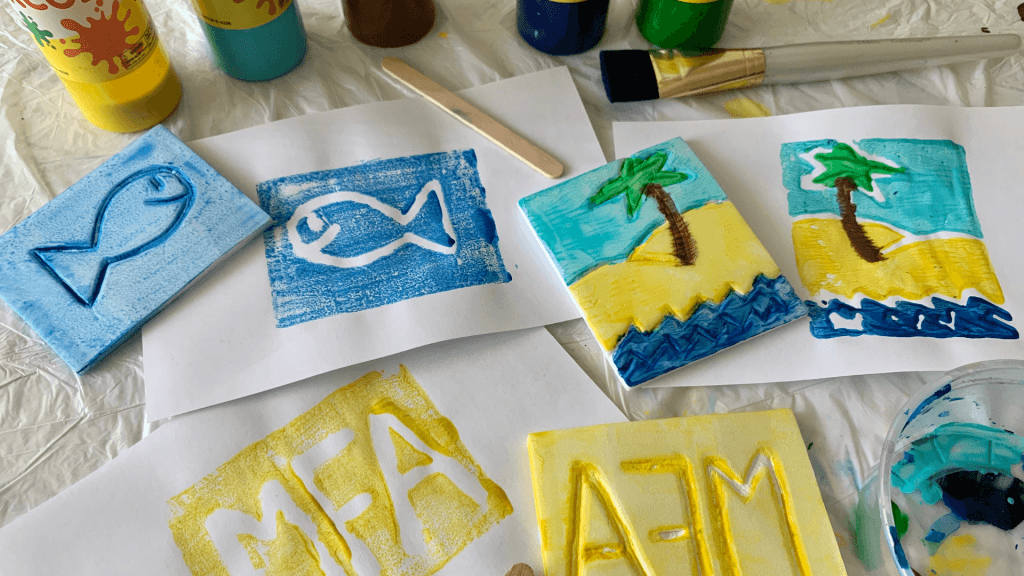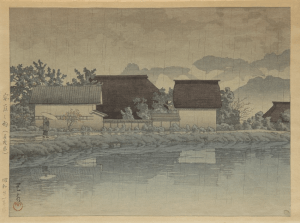Art Break at the MFA! Easy Styrofoam Prints Technique

Art Break at the MFA! Styrofoam Prints
How did artists make copies of their artworks before computers, cameras, or printers were invented? As far back as 220 AD, artists in China and throughout East Asia used a process called woodblock printing to create many identical copies of the same original design!
Making a woodblock print takes several steps. First, the artist creates their design on paper before engraving or carving, it into a wooden block. Then, a carved design, called a relief, is then used as a stamp to make multiple copies of the design on paper. Ink is spread over the relief, and the relief is pressed to the paper. When the relief is removed, the design is then transferred to the paper and is called a print. This process could also be used to create prints on fabric or other surfaces.
In Japan, woodblock prints were popular during the Edo period between 1600 and 1868. The prints were called ukiyo-e, which means “images of the Floating World,” and often showed landscapes, warriors, kabuki actors, and sumo wrestlers. Ukiyo-e prints were brought to Europe in the 1800s and admired by many artists, including Impressionist artist Claude Monet who collected them.
In the early 1900s, Japanese artists began making shin-hanga, or “new prints,” which were inspired by the tradition of ukiyo-e. The MFA has many ukiyo-e and shin-hanga prints in its collection, including Rain at Yasuniwa, Nagano Prefecture by Kawase Hasui. Hasui was one of the masters of shin-hanga landscape prints. This print shows a person walking in the rain along a riverside pathway. Hasui would sketch scenes from his travels that would later be engraved in wood and turned into prints.
Try making a simple print at home! First, decide what your print will depict. Think of your favorite people, animals, places, or abstract designs. Once you’ve chosen your design, follow the steps below to create your masterpiece. Use #MFAfromHome to share your creations with us online!
Materials:
- Styrofoam plate or recycled Styrofoam food container
- Scissors
- A dull pencil, craft stick, chopstick, or other thin tools
- Liquid coloring supplies such as ink or paint
- An extra plate, bowl, or cup for your liquid color
- Paintbrush or roller
- Paper
Directions:
- Use scissors to cut your Styrofoam plate, or takeout container, into a flat shape about the same size as your paper.
- Use your dull pencil, craft stick, or other thin tool to draw your print design into the Styrofoam, pressing down firmly to make an indent in the foam. Anywhere you press down on your foam will show up as a white line in your final print. Your print will be a reverse of your original drawing on the foam, so be sure to write any letters or words backward.
- When you are finished drawing your design, pour your liquid color into a separate plate, bowl, or cup. Then, use your paintbrush or roller to spread your color across your foam. If you are using a roller, your print will be monochromatic (or all one color). If you are using a paintbrush, you could experiment with adding different colors to different parts of your design.
- When your foam is completely covered in color, gently lay your paper down on top and press down firmly. Be sure not to move your paper, or your design could smear. You could also try flipping your foam over onto your paper, using it as a stamp.
- Gently peel your paper and foam apart to reveal your print! Lay your print to the side, and reapply color to your foam to create more. If you want to make prints of your design in multiple colors, gently rinse the foam in water to remove the previous color.
- Optional: To make a print in a style similar to Japanese woodblock artists, use your tool to carve out or press down any areas on the foam you don’t want to show up in your final print.
Image: Kawase Hasui, Japan, 1883-1957, Rain at Yasuniwa, Nagano Prefecture, 1946, Color woodblock print, Gift of B. Abbott in memory of Frankie Bellamy Priest
